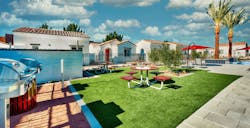Strategies for Prioritizing Amenities in Built-to-Rent Communities
The rapidly growing built-to-rent (B2R) market continues to evolve—and when it comes to attracting potential tenants for this distinctive product, creating and marketing the right amenities can be a game changer.
Like homebuyers, renters present different but still discerning needs, whether they’re young professionals, family-forming Millennials, or empty nesters. Understanding your audience’s everyday lifestyles, which are largely propelled by their current life stages, is vital to planning amenities that will attract and serve their needs while staying profitable as a developer.
Many people immediately think of swimming pools and hot tubs as standard amenities. But for built-to-rent communities, some developers are refining their offerings and getting creative based on what makes their prospective tenants tick.
RELATED
- What’s Driving the Demand for Single-Family Rental Homes?
- Built to Rent Is Booming, But Operational Challenges Loom for This Housing Sector
- Multifamily Rental: Big House, Big Impact in Texas
According to John Burns Real Estate Consulting, amenities make communities more valuable. A sense of community, achieved through the right amenities, can enhance the rent premium beyond a simple dollar-for-dollar basis. According to its B2R community database, John Burns’ current chart-topping amenities include fitness centers, walking trails, pools, and clubhouses.
As the B2R market expands, doing your homework and applying what you learn can result in the most thoughtfully planned amenity packages that advance from “one size fits all” to “Hey, this place is made for me.”
Who’s Living in Built-to-Rent Communities? A Look at Today’s B2R Tenants
Recent findings indicate that a substantial portion of B2R tenants are women, a group that has been shown to respond favorably to amenities that focus on heightened safety. Well-lit parking areas, gated entrances, security patrols, surveillance cameras—even little details like substantial-feeling deadbolts on front doors—are just a few ways to effectively appeal to their safety concerns.
Another discovery, albeit a surprising one for many developers, is the sheer influx of families with young children moving into B2R communities, even when a top school district was not prioritized during site selection for the project.
Potentially fueled by the early days of the pandemic, when many parents faced the daunting challenges of remote schooling and working, families have come to realize they need more room to live, work, and play at home.
More than ever, backyards are a coveted amenity, along with well-designed, family-friendly communities that are conducive to riding bikes and making friends with neighbors. And although it may not seem as significant, a garage with direct access is a highly desirable perk for families hauling in kids (and purchases from Costco!) on a regular basis.
The large volume of young families isn’t the only surprising discovery in recent B2R audience analyses. Dog owners (and their dogs, of course) also sit near the top of most likely B2R tenants.
Tenants can be very amenable to add-on additional rent fees if it means having access to features that score high on convenience and family life.
The large volume of young families isn’t the only surprising discovery in recent B2R audience analyses. Dog owners (and their dogs, of course) also sit near the top of most likely B2R tenants.
Developers have quickly caught on to this growing trend, and pets have become an integral part of the planning and structure of a community. Amenities such as dog parks, fenced dog runs, dog-washing stations, and even spa-like canine grooming centers are gaining popularity and can often be incorporated into a community without a significant investment—compared with other features, such as pools.
For example, a patch of artificial turf is relatively inexpensive yet highly valuable to a dog-loving tenant … one who is likely to pay a monthly premium to have it. Municipal requirements, such as ensuring there is grass or open areas within certain parts of the community for things like water retention, can be creatively reimagined to become dog parks. After you throw in grass, lighting, fencing, gates, seating, and a dog-wash station, you can convert a boring retention area into a monetizable amenity for likely less than six figures.
RELATED
- What the Future Holds for Single-Family Rentals
- Momentum Builds for Build-to-Rent
- To Buy or Not to Buy? Recession Fears Push Sellers and Builders Into Rental Market
Understanding Tenant Needs Associated With Different Life Stages
Understanding, connecting, and catering to renters’ various life stages can transpire in a B2R community in many ways. For example, younger renters (typically between 18 and 23 years of age) tend to show more interest in “social” destinations such as on-site juice bars and hangout halls, since they offer easy ways to mix and mingle with other tenants without leaving home.
And since renters in this age bracket often live with roommates, features such as additional storage spaces become more important and can be presented as a separate price category above the base rent.
More mature working professionals, on the other hand, may only use a handful of community amenities to solve their discreet needs, as opposed to loading up on centralized ones. They value the convenience of having access to workout spaces or a pool to swim in on a hot day, but generally prefer and prioritize personal spaces within their home’s footprint more so than shared spaces.
Don’t Forget the Importance of Amenities Within Rental Units
Carefully considered amenities are critical on the community level, but they count just as much inside. In-unit features such as washer/dryers, premium finishes, and extra storage are a few examples of desirable amenities.
And, more than ever, acknowledging and catering to tech-savvy, eco-conscious tenants, which often fall in the 30 to 35 age range, is paramount. Smart thermostats and smart doorbells are becoming must-haves, but taking it a step further, some developers even offer smart device networks that allow tenants to manage and interact with their units, garages, and community amenities via a smartphone.
Garages are another amenity that scores high on the priority list for B2R renters. “Focus groups continue to show that renters want garages—for storage, safety, and to protect against the elements,” says Vince Barbato, principal of Family Development, an active B2R developer in the Southwest. “This is why even our townhome product offers a two-car garage.”
A Balancing Act
Unlike traditional multifamily rental properties, where just a small portion of the building’s units are deemed premium due to their placement on the building’s corners or ground level, virtually every unit in a B2R community is a first-class, premium unit.
Renters will enjoy more windows, ground-level access, and some private backyard space. These creature comforts are highly valued and are often a driving force for prospective tenants, so it’s important to consider them as part of your built-in amenity package.
Adding to them is important, but it’s a balancing act. The pressure is on when planning high-budget, centralized amenities such as recreation centers, which can run upward of $250 per square foot (and climbing in today’s market), and swimming pools, which can cost up to several hundred thousand dollars and require significant ongoing maintenance.
It’s also not uncommon to overbuild—like adding a juice bar without analyzing your audience’s needs—but if your research is thorough and you know your demographics, that juice bar could also be a home run.
The stakes are definitely high, especially considering many of these renters could own a home, but they chose to rent, so developers must cater to their wants and needs.
“Just like people who purchase homes, renters also have a great appreciation for superior design. So we have made it a point to design luxury lease communities that exceed the design quality of most of today's rental options,” Barbato says. “We try to create communities and homes for the way people ideally want to live in their homes, which translates into an open community land plan, beautiful elevations, and, best yet, floor plan designs that live right.”
The takeaway: It’s not always easy to get your desired returns through tenant rents, and you’re unlikely to see increases in rents that merit the increases in your costs—so plan prudently with an eye on ROI.
Sometimes, that can mean investing less in your amenities and more in marketing them.
Ron Gonski is SVP of growth at Mosaic, a tech-enabled general contractor that builds homes for the nation’s most innovative developers. Mosaic’s home building platform manages every stage of construction by collecting, utilizing, and learning from powerful data. Mosaic standardizes the process, not the homes, enabling developers to make places people love widely available.

